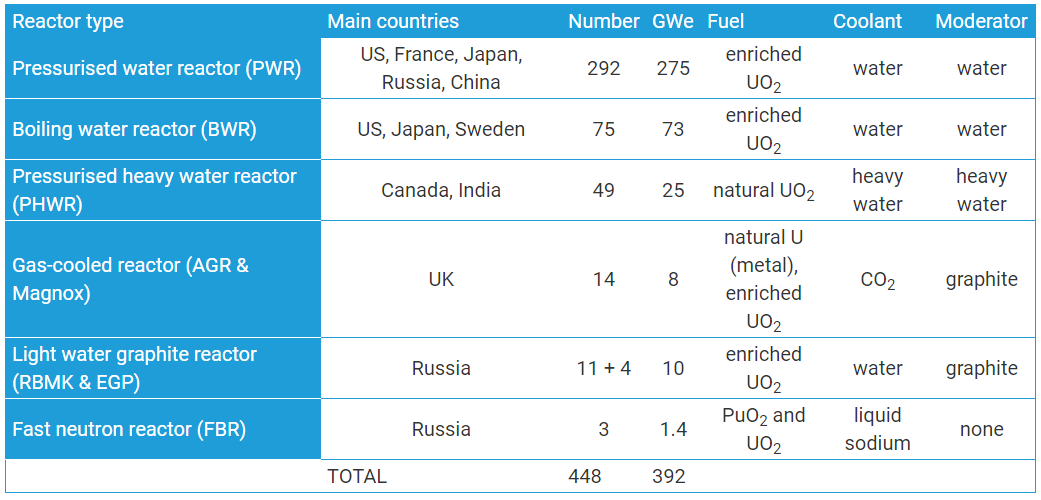
A nuclear reactor produces and controls the release of energy from splitting the atoms of certain elements. In a nuclear power reactor, the energy released is used as heat to make steam to generate electricity. (In a research reactor the main purpose is to utilise the actual neutrons produced in the core. In most naval reactors, steam drives a turbine directly for propulsion.)
The principles for using nuclear power to produce electricity are the same for most types of reactor. The energy released from continuous fission of the atoms of the fuel is harnessed as heat in either a gas or water, and is used to produce steam. The steam is used to drive the turbines which produce electricity (as in most fossil fuel plants).
The world's first nuclear reactors operated naturally in a uranium deposit about two billion years ago. These were in rich uranium orebodies and moderated by percolating rainwater. The 17 known at Oklo in west Africa, each less than 100 kW thermal, together consumed about six tonnes of that uranium. It is assumed that these were not unique worldwide.
Today, reactors derived from designs originally developed for propelling submarines and large naval ships generate about 85% of the world's nuclear electricity. The main design is the pressurised water reactor (PWR) which has water at over 300°C under pressure in its primary cooling/heat transfer circuit, and generates steam in a secondary circuit. The less numerous boiling water reactor (BWR) makes steam in the primary circuit above the reactor core, at similar temperatures and pressure. Both types use water as both coolant and moderator, to slow neutrons. Since water normally boils at 100°C, they have robust steel pressure vessels or tubes to enable the higher operating temperature. (Another type uses heavy water, with deuterium atoms, as moderator. Hence the term ‘light water’ is used to differentiate.)
Components of a nuclear reactor
There are several components common to most types of reactors:
Fuel. Uranium is the basic fuel. Usually pellets of uranium oxide (UO2) are arranged in tubes to form fuel rods. The rods are arranged into fuel assemblies in the reactor core. In a 1000 MWe class PWR there might be 51,000 fuel rods with over 18 million pellets.
Moderator. Material in the core which slows down the neutrons released from fission so that they cause more fission. It is usually water, but may be heavy water or graphite.
Control rods. These are made with neutron-absorbing material such as cadmium, hafnium or boron, and are inserted or withdrawn from the core to control the rate of reaction, or to halt it. In some PWR reactors, special control rods are used to enable the core to sustain a low level of power efficiently. (Secondary control systems involve other neutron absorbers, usually boron in the coolant – its concentration can be adjusted over time as the fuel burns up.) PWR control rods are inserted from the top, BWR cruciform blades from the bottom of the core.
Coolant. A fluid circulating through the core so as to transfer the heat from it. In light water reactors the water moderator functions also as primary coolant. Except in BWRs, there is secondary coolant circuit where the water becomes steam. (See also later section on primary coolant characteristics.) A PWR has two to four primary coolant loops with pumps, driven either by steam or electricity – China’s Hualong One design has three, each driven by a 6.6 MW electric motor, with each pump set weighing 110 tonnes.
Pressure vessel or pressure tubes. Usually a robust steel vessel containing the reactor core and moderator/coolant, but it may be a series of tubes holding the fuel and conveying the coolant through the surrounding moderator.
Steam generator. Part of the cooling system of pressurised water reactors (PWR & PHWR) where the high-pressure primary coolant bringing heat from the reactor is used to make steam for the turbine, in a secondary circuit. Essentially a heat exchanger like a motor car radiator. Reactors have up to six 'loops', each with a steam generator. Since 1980 over 110 PWR reactors have had their steam generators replaced after 20-30 years service, 57 of these in USA.
Containment. The structure around the reactor and associated steam generators which is designed to protect it from outside intrusion and to protect those outside from the effects of radiation in case of any serious malfunction inside. It is typically a metre-thick concrete and steel structure.
Newer Russian and some other reactors install core melt localisation devices or 'core catchers' under the pressure vessel to catch any melted core material in the event of a major accident.
There are several different types of reactors as indicated in the following table.
Nuclear power plants in commercial operation or operable

